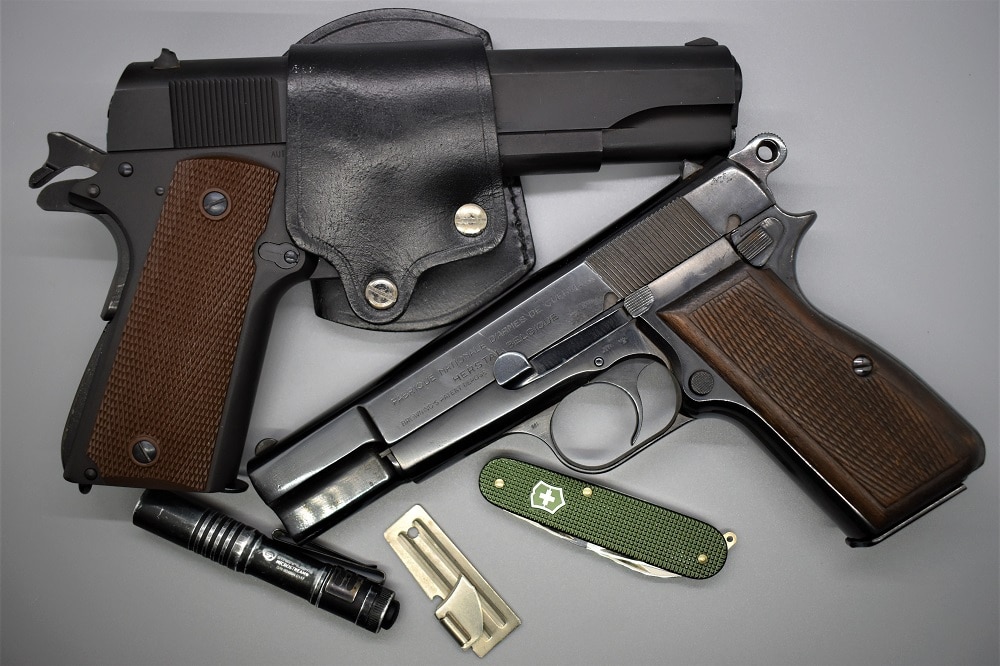
Some things, like an M1911A1 GI, a Browning Hi-Power, a Swiss Army knife or a P-51 can opener, have been augmented by more modern offerings but that doesn’t mean they stop working as designed. (Photo: Chris Eger/Guns.com)
Utah firearms genius John Browning was something of the Thomas Edison of American gun development, but are his best-known pistols still up to snuff for EDC use today?
With that in mind, after using and, yes, occasionally carrying these guns off and on for the past several decades, here is my take.
The M1911
Developed from a string of designs across the early 20th Century to compete in a variety of U.S. Army trials for a modern handgun that didn’t have a revolving cylinder, the Model of 1911 proved popular enough that Uncle Sam kept it around as the GI standard sidearm for a solid 75-year run. When you think of the National Match handguns, tough-guys like Lee Marvin or Humphrey Bogart, or the leather holsters hanging on the side of every pistol-carrying American Marine or Soldier in WWI, WWII, Korea or Vietnam, it is the M1911 that comes to mind. They have been loved and carried by those as diverse as Hank Williams, Jr. and William S. Burroughs. A pistol with a universal adapter, if you will.
With millions of these guns produced by a score of companies around the globe– just about every modern handgun maker in the U.S. cranks out a version of the M1911A1– these guns have been standard in many families for use in home defense or carry in times both strange and familiar, and were often kept around, “just in case.” The “old .45” thus became a proxy member of the tribe, handed down from generation to generation. For those skipped or who missed out on inheriting the heirloom, the appeal of reaching back to the same 39-ounce piece of mind via a new M1911 is often a stepping stone to restore that lost piece of the family puzzle.
There is a reason that this 109-year-old design is still in full-speed production. It is an icon.
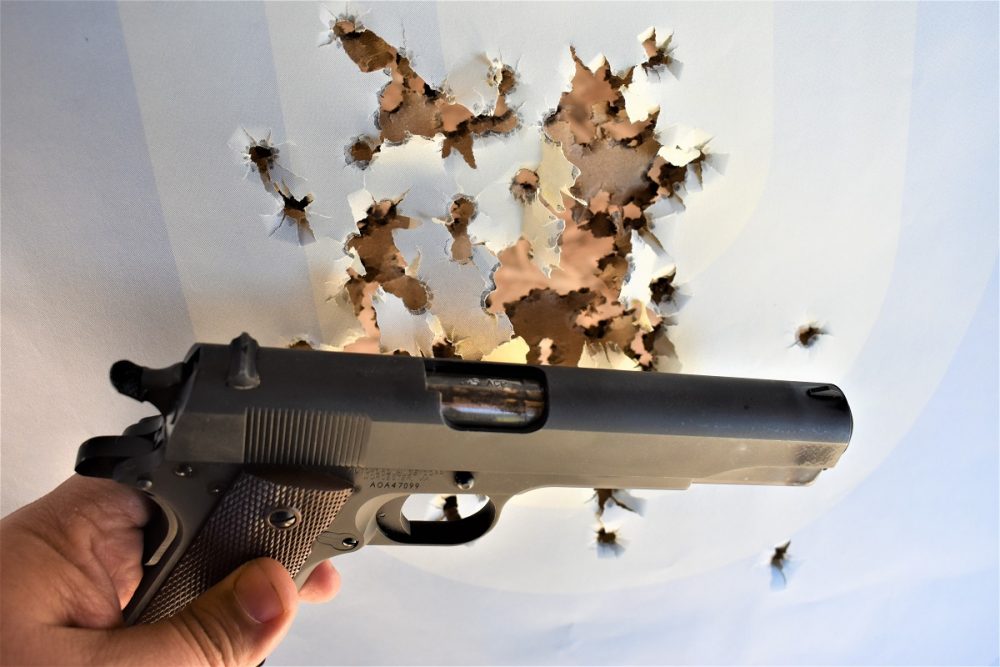
The M1911 platform lends itself to accuracy, such as this entry-level Auto Ordnance BKO with period-style sights and bulk ammo offhand at 25 yards (Photo: Chris Eger/Guns.com)
These pistols have, on the flip-side of the coin, often gotten the short shrift as “boomer guns” or “jam-a-matics” and have been eschewed by many modern shootists who prefer things more polymer-framed, striker-fired and modular. Further, single-action and Condition One is a learning curve that, when compared to a Glock, is comparable to figuring out how to drive a stick-shift: if you have someone to show you, its no big deal but left to figure it out on your own it can be hairy.
To be fair, an M1911 is heavy by comparison to today’s less-vintage designs, is often a bit tricky to field strip and maintain for those inexperienced with them, and frequently still require a manufacturer-suggested “break-in period” of several hundred rounds to function reliably.
Speaking of reliability, poorly made clones, guns of questionable background, an enduring glut of homebuilt kit guns going back to the Reagan-era, and worn-out military surplus mixmaster pieces that would make Frankenstein look like a genetically perfect super soldier, are often to blame for the bad wrap.
The rub: a guy who has never fired a M1911 shoots his buddy’s gun, has a bad experience due to a mixture of causes, then gets soured on the entire platform– no matter who made the gun– declaring from that point on that, “1911s suck, man.” The same can be said about ARs or AKs, other examples of good designs that have had inherent flaws magnified by production in great quantity and of mixed quality. If you have a bad experience with one, it could jade you on the platform as a whole, which is a fundamental mistake. There are dozens of firms cranking out quality builds that are unfortunately lumped into the general “type” and don’t belong in that category.
Further, with the widespread availability of M1911 parts and those who are skilled at fitting them, the likelihood is high that an M1911 that does get cranky can be rectified so long as the frame and slide are intact. Likewise, with so many companies producing these guns, there is any number of chopped down Commander and Officer-sized models with 3-inch barrels, as well as those tweaked for carrying. Want rails? They are out there. Want a 9mm, 10mm, or .38 Super instead of .45ACP? You can bet they are out there as well. Want more capacity? There are double stacks and 2011-style guns.
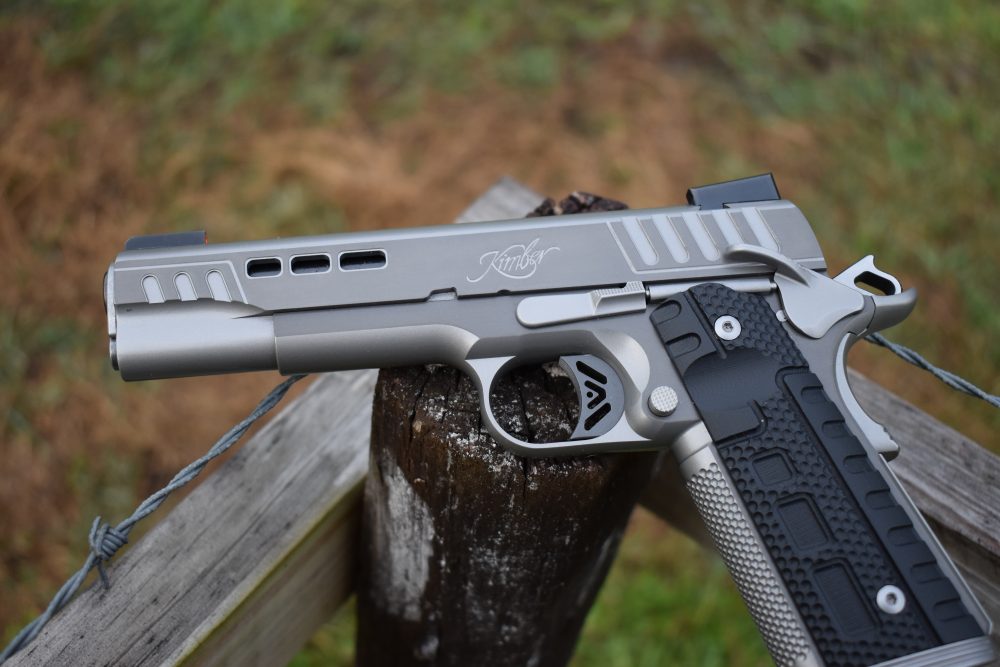
More upscale M1911A1s, such as this Kimber Rapide in 10mm Auto, bring a host of enhanced features including better sights, triggers, and ergonomics. John Browning’s ghost could likely come across this gun today and still recognize his design. (Photo: Chris Eger/Guns.com)
To be sure, carrying an M1911 is different from a Sig P365, but people have somehow been pulling it off for over a century. With the right holster, it is not hard. For concealed carry, an easy search of Kydex IWB holsters will bring pages of options including some from decent makers like JM Custom and Keepers Concealment. With a good holster and belt, move into ammo selection and make sure it all works together through practice. This premise works with all M1911s from $350 Rock Islands through Wilson Combat guns that cost more than a good used Toyota Hilux.
SEE M1911s OF ALL KINDS IN STOCK
But what of the Hi-Power?
Ahh, so if you waded this far, you may ask about the viability of the classic Browning/FN Hi-Power or possibly its clones by Charles Daly, KBI, Tisas, FM, Arcus et. al. After all, the BHP came a full generation after the M1911, is almost twice the capacity–especially when using today’s excellent updated Mec-Gar 15-round flush-fit mags, and has a simpler take down due to the deletion of the M1911’s barrel bushing.
For sure, the BHP saw a more widespread adoption outside of the U.S. than the M1911, probably because it was the first production 9mm semi-auto with a detachable double-stack mag. Employed by something like 40 different countries, there are still lots of Hi-Powers in active military service around the world today, such as with the armies of Australia and Canada.
For use as a carry and home defense gun in the U.S., it should be noted that the BHP was the king of the hill in the capacity game from the 1940s through the mid-1970s when the S&W Model 59, Beretta 92, and CZ 75 finally caught up and arrived with the trump card of being double-action. Sadly, perhaps, the Hi-Power never morphed through the same cornucopia of variations that the M1911 did, although Browning/FN did produce some in .40S&W as well as the double-action BDA, among other models.
To be sure, customized carry BHPs by Novak, Nighthawk, Wilson Combat, and the like are functional art pieces, but with European production of the base platform ended a few years back, the well has run dry. Further, Hi-Power rail guns are a unicorn.
Nonetheless, with millions of Hi-Powers floating around of all grades ranging from rare collectibles that will (and should) remain safe queens to beat-up milsurp and former police guns imported from overseas, there are undoubtedly several still being used as carry pieces today. If they work– and if the springs are swapped out as needed they likely will continue to for decades–why not?
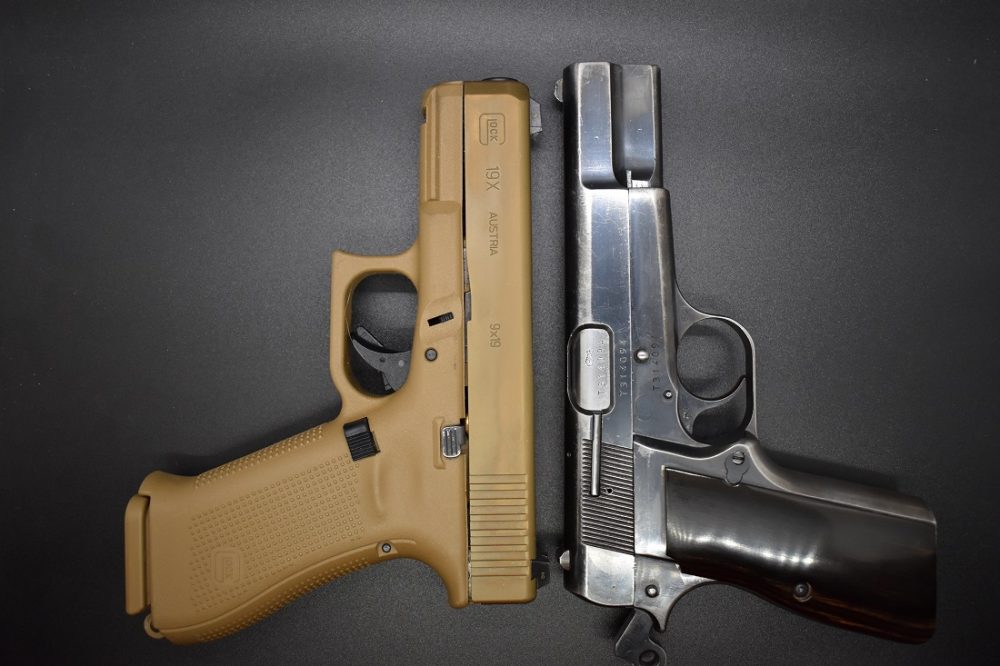
Comparing 1930s tech with today’s best, the FN Browning T-Series Hi-Power on the right brings 15+1 rounds of 9mm to the party with a Mec-Gar mag and is reliable with modern JHP rounds. The G19X, a Gen 5 Glock, has a 17+1 capacity as shown and comparable dimensions. The weight difference, with both guns fully loaded, shows the G19X to be just 4.7-ounces lighter, although it does have the benefit of better sights, a tougher option on legacy BHPs. In the Browning’s court is the fact that it can take any number of aftermarket grip panels, a non-factor for the Glock. (Photo: Chris Eger/Guns.com)
In the end, probably the best school of thought on if a handgun can work for you as an every day carry piece is that you A) shoot it well enough to be accurate with it, B) find it reliable enough with defensive ammo to stake your life on and C) can find an effective carry method.
If your pistol meets those guidelines, arguing online or at the gun shop counter against someone willing to die on their hill of choices with wholehearted conviction is a waste of time that you will not get back– not to mention, it takes away from your time at the range.
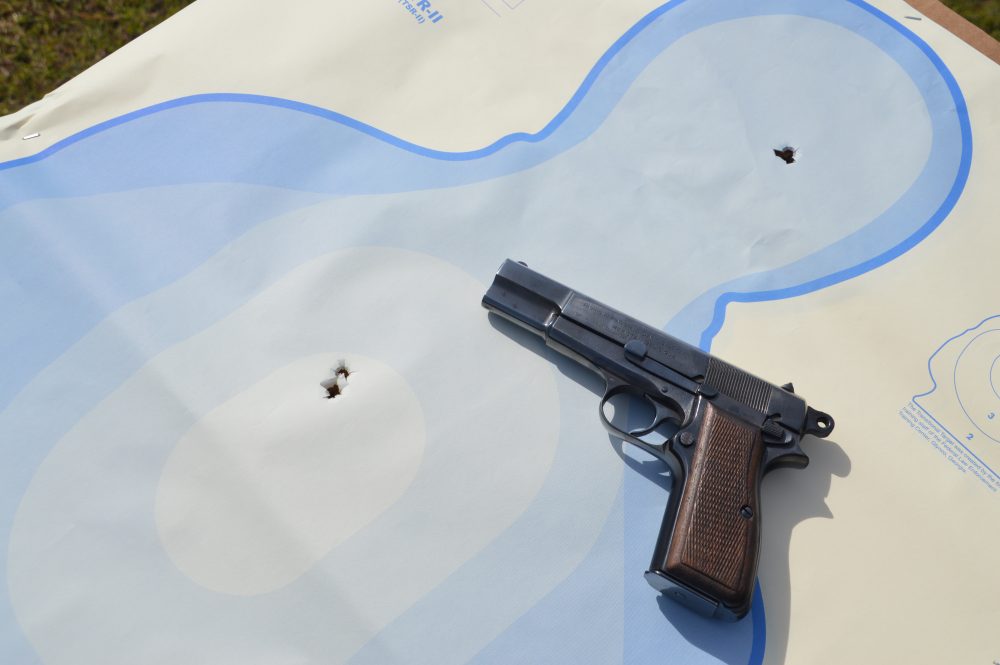
Mr. Browning’s best-known kids can still deliver– if you get to know them. (Photo: Chris Eger/Guns.com)
SEE DEALS ON BROWNING HI-POWERS
The post Are John Browning’s Best Known Kids Still Up to Muster for EDC appeared first on Guns.com.
